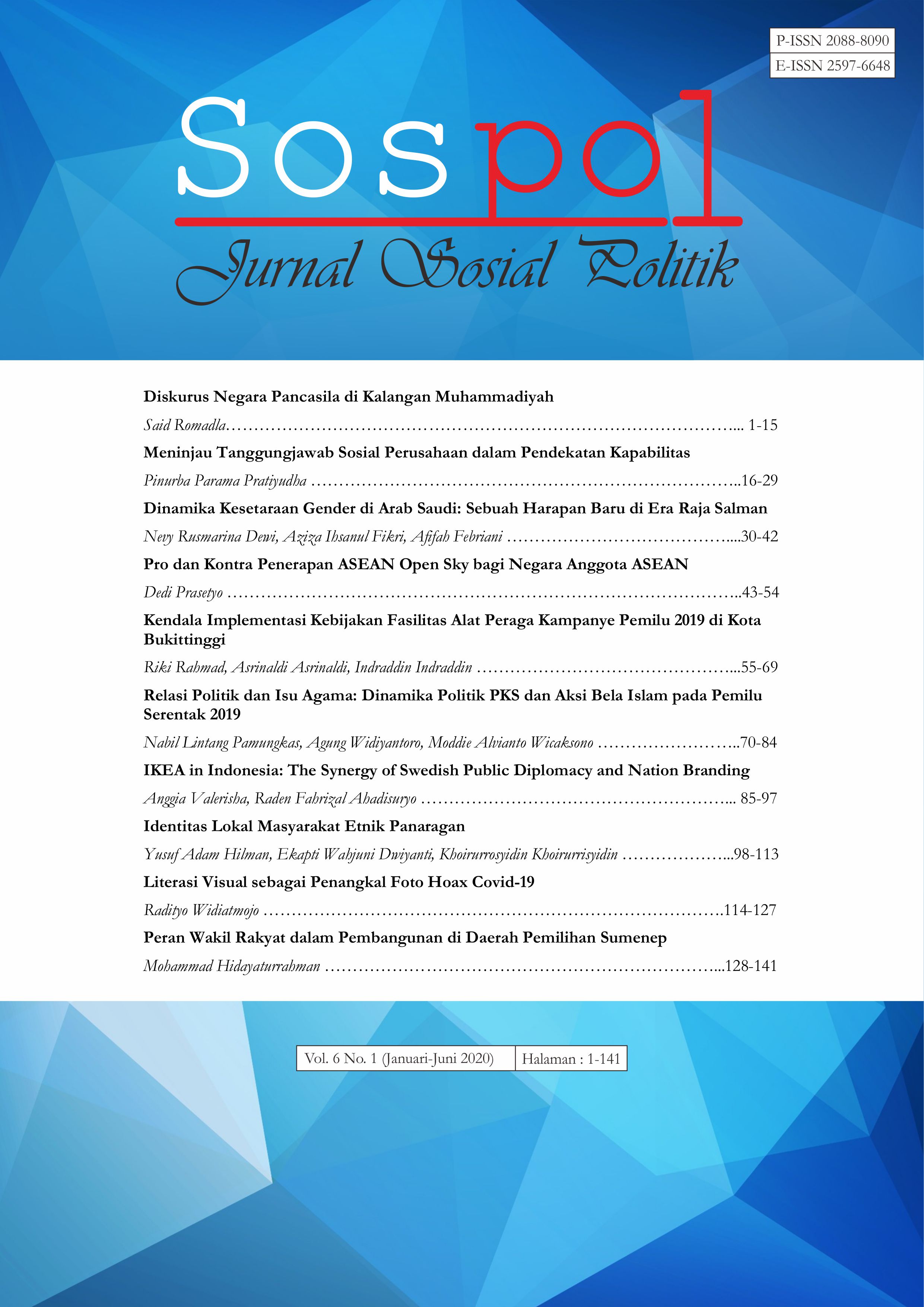IKEA in Indonesia: The Synergy of Swedish Public Diplomacy and Nation Branding
DOI:
https://doi.org/10.22219/sospol.v6i1.11170Keywords:
IKEA, Indonesia, Nation-branding, Public diplomacy, Swedia.Abstract
Public diplomacy and nation-branding are two popular concepts and closely related to diplomacy activities by both state and non-state actors. Szondi discusses the possible inter-connections of the two concepts and formulates understanding on how his concept can help to explain the various attempts of both state and non-state actors in achieving national interest. The unit analysis of this study is Sweden as state actor and IKEA as multi-national corporation. The existence of IKEA as company with its global-popular brand has becoming concerns for further research particularly on how IKEA brand as the instrument to supports Sweden’s public diplomacy. This study aims to analyze Swedish public diplomacy and nation-branding in Indonesia through the IKEA brand as the case study and by using the model of public diplomacy and nation-branding proposed by Szondi. The study uses qualitative method with data collection carried out through documentation studies from 2014-2018. The findings indicate that the IKEA brand has unique characteristics. In Szondi’s model, IKEA brand positioned in the incision between the area of public diplomacy activities and the area of nation-branding, which is described by Szondi as the fourth model. Through the IKEA brand, there is a synergy between Swedish public diplomacy activities and its nation- branding strategy. The IKEA brand has succeeded not only in the promotion of its products or companies, but also contributed to a positive image and reputation of Sweden and, increase social and economic engagement with Indonesia.
Downloads
References
Ahadisuryo, R. F. (2018). Upaya Nation Branding Swedia oleh IKEA di Indonesia [Parahyangan Catholic University]. https://doi.org/http://hdl.handle.net/123456789/8402
Anholt, S. (1998). Nation-Brands of the Twenty-First Century. Journal of Brand Management, 5(1), 395–406. https://www.semanticscholar.org/paper/Nation-brands-of-the-twenty-first-century-Anholt/b484bc436f3ec3caa6e2745fb6ef0e7b6ea66655
Anholt, S. (2010). Places: Identity, Image and Reputation. Palgrave Macmillan.
Anholt, S. (2013). Beyond the Nation Brand: The Role of Image and Identity in International Relations. Exchange: The Journal of Public DIplomacy, 2(1), 6–12. https://surface.syr.edu/exchange/vol2/iss1/1
Antara News. (2017). Indonesia, Sweden Sign Three Agreements. https://en.antaranews.com/news/111036/indonesia-sweden-sign-three-agreements
BBC News. (2018). Sweden Country Profile. BBC. https://www.bbc.com/news/world-europe-17955808
Business Sweden. (2019). Business Sweden. http://business-sweden.se
Country Economy. (2019). Sweden Profile. www.countryeconomy.com
Cull, N. J. (2006). “Public Diplomacy” Before Gullion: The Evolution of a Phrase. USC Centre on Public Diplomacy.https://www.uscpublicdiplomacy.org/blog/public-diplomacy-gullion-evolution-phrase
Cull, N. J., & Sadlier, D. J. (Darlene J. (2009). Public Diplomacy : Lessons from the Past (N. J. Cull (ed.)). Figueroa Press.
Datantify. (2018). Swedish Global Brands. www.datantify.com
Efe, S. (2017). Public Diplomacy and The Implementation of Foreign Policy in the US, Sweden and Turkey. Palgrave Macmillan. https://doi.org/10.1007/978-3-319-49334-3
Effendi, T. D. (2013). Diplomasi Publik sebagai Pendukung Hubungan Indonesia-Malaysia. Jurnal Ilmiah Hubungan Internasional, 9(1), 46–61.
Fan, Y. (2010). Branding the nation: Towards a better understanding. Journal of Place Branding and Public Diplomacy, 6, 97–103. https://doi.org/10.1057/pb.2010.16
Goodman, M. B. (2006). The Role of Business in Public Diplomacy. Journal of Business Strategy, 27(3), 5–7. https://doi.org/10.1108/02756660610663763
Hapsoro, B. (2019). Furthering Indonesia-Sweden Good Relations (Opinion). The Jakarta Post.
Hennida, C. (2009). Diplomasi Publik dalam Politik Luar Negeri. Jurnal Masyarakat, Kebudayaan Dan Politik, XXII(1), 17–23.
IKEA. (2019a). About Us: IKEA. www.ikea.com
IKEA. (2019b). IKEA Indonesia. www.ikea.co.id
Kaneva, N. (2011). Nation Branding: Toward an Agenda for Critical Research. International Journal of Communication, 5(0), 25.
Kementerian Luar Negeri RI. (2019). Indonesia-Sweden. www.kemlu.go.id
Leonard, M., Stead, C., Smewing, C., & Foreign Policy Centre (London, E. (2002). Public Diplomacy. Foreign Policy Centre. http://www.fpc.org.uk
Nye, J. S. (2004). Soft Power: The Means to Success in World Politics.
Olle Wastberg. (2009). The Brand Symbiosis of Sweden and IKEA. https://nation-branding.info/2009/07/08/brand-symbiosis-sweden-ikea/
Perrson, J. (2017). Sweden and Indonesia Signs Defence MoU. Scandasia. https://scandasia.com/sweden-and-indonesia-signs-defence-mou/
Rosi, A. (2017). Swedish Nation Branding in Crisis: A study on the Swedish Nation Branding Strategy and the Migration Crisis’ Impact. Uppsala Universiteit.
Speirs, A. (2017). An Interview with H.E. Johanna Brismar-Skoog. Now Jakarta. https://nowjakarta.co.id/people/now-people/an-interview-with-h-e-johanna-brismar-skoog-ambassador-of-sweden-to-indonesia
Sweden Government. (2019). Sweden Government. https://www.government.se
Sweden Ministry for Foreign Affairs. (2005). Images of Sweden Abroad - A Study of the Changes, The Present Situation and Assessment Methods. www.imagebank.sweden.se
Szondi, G. (2008). Public Diplomacy and Nation Branding: Conceptual Similarities and Differences.
Teslik, L. H. (2007). Nation Branding Explained. Council of Foreign Relations. https://www.cfr.org/backgrounder/nation-branding-explained
The Swedish Institute. (2019). The Swedish Institute. https://www.si.se
U.S. Department of State in Public Diplomacy Alumni Association. (1987). Dictionary of International Relations Terms; What is Public Diplomacy? http://www.publicdiplomacy.org/1.htm
Wang, J. (2006). Public Diplomacy and Global Business. Journal of Business Strategy, 27(3), 41–49. https://doi.org/10.1108/02756660610663826Downloads
Published
How to Cite
Issue
Section
License
Authors who publish with this journal agree to the following terms:
- Authors retain copyright and grant the journal right of first publication with the work simultaneously licensed under a Creative Commons Attribution-ShareAlike 4.0 International License that allows others to share the work with an acknowledgement of the work's authorship and initial publication in this journal.
- Authors are able to enter into separate, additional contractual arrangements for the non-exclusive distribution of the journal's published version of the work (e.g., post it to an institutional repository or publish it in a book), with an acknowledgement of its initial publication in this journal.
- Authors are permitted and encouraged to post their work online (e.g., in institutional repositories or on their website) prior to and during the submission process, as it can lead to productive exchanges, as well as earlier and greater citation of published work (See The Effect of Open Access).

This work is licensed under a Creative Commons Attribution-ShareAlike 4.0 International License.



















